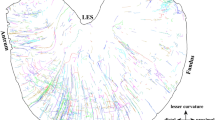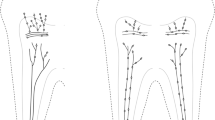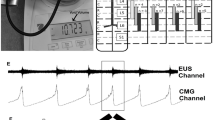Abstract
Neuropeptides were first localized in the human spinal cord by immunocytochemistry1 and substance P has been shown, by the same method, to be reduced ipsilaterally in the dorsal horn after limb amputation2 and bilaterally in the Riley–Day syndrome3. Several neuropeptides increasingly fulfil the criteria to establish them as neurotransmitters or neuromodulators4, and they may also have trophic actions in the spinal cord5. Using radioimmunoassay and immunocytochemistry, we present here for the first time a quantitative regional distribution and localization of vasoactive intestinal polypeptide (VIP), substance P, somatostatin, bombesin and cholecystokinin (CCK-8) in normal postmortem human spinal cord. A comparison of the distribution of these peptides reveals an exceptional pattern for VIP, with relatively much higher levels in the lumbosacral region. Immunocytochemical analysis shows a distinctive distribution of VIP-containing fibres and terminals at the lumbosacral segments. This VIP-containing system may have an important role in the spinal control of urogenital function in man.
This is a preview of subscription content, access via your institution
Access options
Subscribe to this journal
Receive 51 print issues and online access
$199.00 per year
only $3.90 per issue
Buy this article
- Purchase on Springer Link
- Instant access to full article PDF
Prices may be subject to local taxes which are calculated during checkout
Similar content being viewed by others
References
Cuello, A. C., Polak, J. M. & Pearse, A. G. E. Lancet ii, 1054 (1976).
Hunt, S. P., Rosser, M. N., Emson, P. C. & Clement-Jones, V. Lancet i, 1023 (1982).
Pearson, J., Brandeis, L. & Cuello, A. C. Nature 295, 61–63 (1982).
Kelly, J. S. Br. med. Bull. 38, 283–290 (1982).
Wall, P. D. & Fitzgerald, M. Ciba Fdn Symp. 91, 249–266 (1982).
Edwardson, J. S. & McDermott, J. R. Br. med. Bull. 38, 259–264 (1982).
Bloom, S. R. & Long, R. G. Radioimmunoassay of Gut Regulatory Peptides (Saunders, London, 1982).
Gibson, S. J., Polak, J. M., Bloom, S. R. & Wall, P. D. J. comp. Neurol. 201, 65–79 (1981).
Morgan, C., Nadelhaft, I. & de Groat, W. C. J. comp. Neurol. 201, 415–440 (1981).
Petras, J. M. & Cummings, J. F. J. comp. Neurol. 146, 189–218 (1972).
de Groat, W. C. Brain Res. 87, 201–211 (1975).
Nathan, P. W. & Smith, M. C. J. Neurol. Neurosurg. Psychiat. 21, 177–189 (1958).
Comarr, A. E. in The Neurogenic Bladder (ed. Boyarsky, S.) 147–152 (Wilkins, Baltimore, 1967).
Author information
Authors and Affiliations
Rights and permissions
About this article
Cite this article
Anand, P., Gibson, S., McGregor, G. et al. A VIP-containing system concentrated in the lumbosacral region of human spinal cord. Nature 305, 143–145 (1983). https://doi.org/10.1038/305143a0
Received:
Accepted:
Issue Date:
DOI: https://doi.org/10.1038/305143a0
This article is cited by
-
De novo aging-related NADPH diaphorase positive megaloneurites in the sacral spinal cord of aged dogs
Scientific Reports (2023)
-
The Role of Vasoactive Intestinal Polypeptide and Pituitary Adenylate Cyclase-Activating Polypeptide in the Neural Pathways Controlling the Lower Urinary Tract
Journal of Molecular Neuroscience (2008)
-
The role of endogenous nerve growth factor in human diabetic neuropathy
Nature Medicine (1996)
-
Regional changes of ciliary neurotrophic factor and nerve growth factor levels in post mortem spinal cord and cerebral cortex from patients with motor disease
Nature Medicine (1995)
-
Immunocytochemical study of the relations of acetylcholinesterase, enkephalin-, substance P-, choline acetyltransferase- and calcitonin gene-related peptide-immunoreactive structures in the ventral horn of rat spinal cord
Histochemistry (1990)
Comments
By submitting a comment you agree to abide by our Terms and Community Guidelines. If you find something abusive or that does not comply with our terms or guidelines please flag it as inappropriate.



